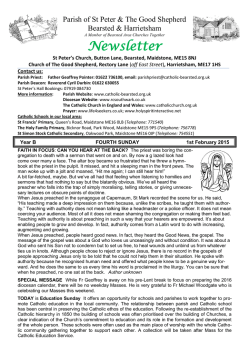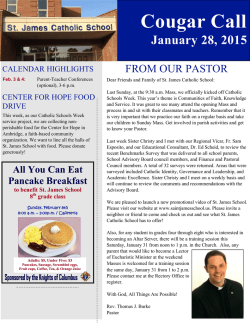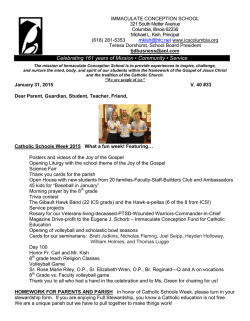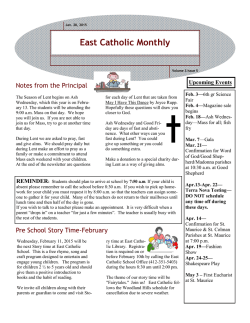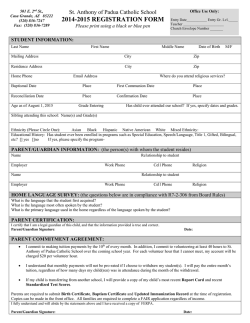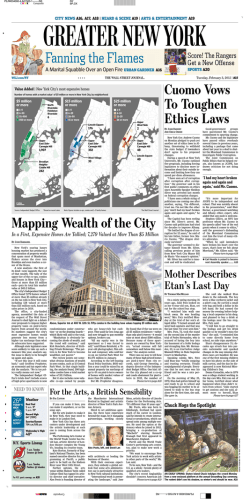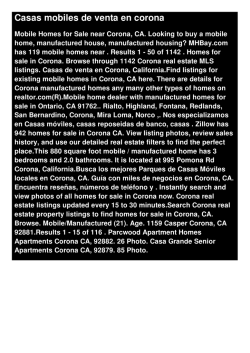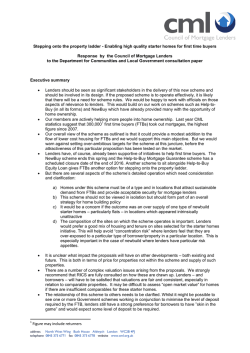
work case studies - Catholic Homes
to n u r rk t Re wo CASE STUDY CATHOLIC HOMES “Valuing your employees is good for people and for business ” The Organisation Catholic Homes is a not-for-profit organisation in the aged care services sector. It provides residential aged care, retirement living and respite care to approximately 1300 seniors in the Melbourne area and has 800 staff and volunteers. Aged care facilities are the biggest arm of its business with 11 sites. Recently the retirement living sector has seen growth and Catholic Homes is working towards an integrated approach for retirement living, aged care and community services, by providing a continuum of care. Catholic Homes also provides independent living support for people in need. Typical work tasks involve nursing care of older people, including physical tasks such as resident transfers between beds and chairs, showering and toileting residents, as well as moving residents in wheelchairs and beds. Other tasks include feeding residents and assisting with diversional therapy sessions. There are also office tasks to be completed by nursing staff as well as office-based positions. Key Initiatives and Achievements Tips and Tricks Suggestions from Catholic Homes to other organisations Value your employees Your employees are key assets to your organisation. Your job as an employer is to genuinely look after them. By making the health and safety of your employees your key outcome, you are ultimately going to make your workplace a happier and more productive place. Good systems A good system around health and safety allows everyone the chance to know how to keep themselves and their workmates safe. It gives you the opportunity to be proactive about injuries and it also means that you can look for trends in reported incidents and do something about risks before they become a problem. Management Leadership must be driven from above and if your executive is committed to change and make the health and safety of employees the key focus, without exception, then staff will follow suit. New thinking and commitment to the wellbeing of all staff has to be driven from the executive and ingrained in the organisational culture. Published by Safe Work Australia: February 2015 www.swa.gov.au Catholic Homes made work health and wellness a key priority for its business after a spike in workers’ compensation claims in the late 2000s. The executive decided to strengthen the work health and safety committee and place dedicated people into key roles. Prior to this, work health and safety services had been delivered by third party providers. The new key roles include a Quality and Risk Manager, Occupational Health and Risk Coordinator and Health and Safety Representatives at each site. As a result of the changed executive focus, the workplace culture has shifted to one characterised by staff members having a great deal of commitment and buy in to health and safety. Major Themes Organisational commitment to safety and return to work It is one thing to talk about taking safety seriously but quite another to shift a business with 800 staff to implement this ethos. The first step for Catholic Homes was recognition by management of the need to strengthen the focus on safety. The second was the appointment of dedicated staff members to manage work health and safety. Through the organisational commitment to worker health, safety and wellbeing, Catholic Homes has successfully reduced its injury and incident rate, decreased workers’ compensation premiums, and increased staff engagement and retention. The role of Health and Safety Representatives was also strengthened across the organisation in response to the cultural shift. Health and Safety Representatives attend a compulsory five day training session before they take on their role, followed up by annual refresher training. Additional work hours are also allocated for Health and Safety Representatives to follow up on incidents and hazards with staff and management. 1 to n u r rk t Re wo CASE STUDY CATHOLIC HOMES themselves needing to take time off work if the burns became infected. Catholic Homes deployed a number of strategies to manage and prevent injuries caused by minor burns. The first was early intervention; which included the provision of treatment as soon as a burn had occurred. Catholic Homes would then support the worker in seeking medical assistance beyond first aid (if required). The worker would also be offered a range of suitable alternative duties, so they could return to work as soon as possible. The second strategy was to conduct a risk assessment to identify how the risk could be managed. New policies and procedures were written up, staff were trained on burn prevention and an awareness campaign was run throughout each site to prevent further injuries. Staff on the health and safety team are the first to respond to all reported staff, contractor, volunteer or visitor incidents/injuries. This may include the provision of first aid, discussions with the doctor and establishment of suitable duties. All staff members injured at work are offered the option of having someone from the organisation accompany them to the doctor. Good communication between the health and safety team, management, the worker and any third party service providers ensures injured workers are looked after and returned to work as soon as possible. The change in focus is illustrated by the experience of one worker who reported that when she was injured 14 years ago she was not allowed to return until she was ‘fully fit.’ She felt disconnected from the workplace and worried about her ability to return to work. However, when her second injury occurred she was able to return and recover at work. She felt connected to her work peers, felt that the employer (Catholic Homes) cared for her and was given the opportunity to learn a range of new skills due to the design of the suitable duties plan. “14 years ago I wasn’t allowed to come back until I was 100% fit but I got bored and I wanted to come back. Now when I had an injury I could come back, and I got to learn new things because I got to try new jobs” Minimising risk The health and safety committee drives improvements across the business and has both an early intervention and incident prevention role. When an injury occurs it is dealt with immediately and there is a proactive approach to managing the claims. Catholic Homes considers a problem dealt with immediately will stay a small problem rather than being exacerbated through delay. Minor burns are an example of this approach. In the past a lack of correct first aid resulted in further complications due to poor management of the injury. Some even found Published by Safe Work Australia: February 2015 www.swa.gov.au If an injury does occur within Catholic Homes it is seen as an opportunity for further improvement. In another incident a minor injury occurred through the incorrect use of bed slings, indicating staff and residents were at risk of injury. The team trialled a new way of using the slings, and wrote a clear process around sling use. Incidents related to sling use have ceased. Another example is an injury caused by a broken trolley wheel. Firstly, the worker was assisted through early intervention procedures, such as engaging their nominated treating doctor, being offered suitable duties and being provided with timely treatment to return to work as soon as possible. The second step was to conduct a risk assessment which identified that all trolley wheels were at risk of breaking and were a potential cause of further injuries. All trolley wheels were immediately replaced and regular safety inspections are now carried out as part of the environmental audits and maintenance ‘walk-a-rounds’. “You need to minimise risk and do the best that you can” Retaining an ageing workforce The Workability Project within Catholic Homes is an initiative to retain older workers in a working environment that can pose risks due to the unpredictable nature of working with patients. The average age of the workforce in Catholic Homes is between 40 and 50 years and staff retention is high. One of the areas of focus has been ‘flexibility’ in shift work. The rationale is that flexibility in the length of shifts as well as the amount of physical work undertaken during the shift, or a combination of both, may reduce the possibility of injury for older workers. Catholic Homes reports that “being flexible around shifts and tasks are key components of successful return to work outcomes” “We need to change the way we think” In another initiative, Catholic Homes looked at combining a variety of suitable roles in sites across the business including retirement care, lifestyle management and community care. The various branches of the business 2 to n u r rk t Re wo CASE STUDY CATHOLIC HOMES Looking after everyone Staff and the health and safety team not only work closely together but also run a number of fun activities to engage staff. This includes ‘Feel Good Days’ that involve all staff engaging in a fun day around health and wellness and quarterly visual displays that target one area of learning, such as first aid for burns or manual handling. Visual displays have been a key risk reduction technique given the high proportion of workers with English as a second language. Visual displays are placed in high staff traffic areas, such as the common staff room and feature one issue a month. Analysis is conducted on the rate of incidents reported in relation to the most recent display. The health and safety team report that there has always been a drop in incidents related to the campaign issue after it has been run. contain a variety of roles that allow for a combination of administrative work and manual handling tasks to vary the working day. It also looked at varying shift times. Shifts in a hospital environment normally require the worker to be on the floor for a 7.6 hour shift. The Workforce Project explored the viability of a 4 or 6 hour shifts. Increasing the flexibility of how work tasks and hours are organised has resulted in a reduction of incident reporting, as workers are not exposed to excessive manual handling. This has also allowed older staff to remain engaged in the workforce for much longer. “Due to workforce ageing the structure of the roles needs to change because people are getting physically unable to participate to their former ability” THE BOTTOM LINE Catholic Homes’ premium rate has been decreasing since 2010/11 as a direct result of assisting workers to return to work via exemplary return to work strategies. Its premium rate decreased 75 per cent from 5.327% in 2010/11 to 1.3502% in 2013/14. Consultation is key Consultation with staff is key to driving sustainable change: “Until we talk to our people at the coal face that do the doing, then we don’t know if any of the changes are working. We need to be able to talk to people to have any changes sustained and embedded”. Each site has a local committee that meets bi-monthly, with a combined committee from all the sites meeting on alternate months. The committees have impacted on the organisation by encouraging open communication between all staff, the sharing of ideas and dissemination of information managed at an organisational level. Open communication and consulting with staff has result in: • risks being managed immediately when an incident is reported, therefore reducing potential injuries in the future • high staff engagement, which indicates high levels of staff satisfaction with their employer, and • high staff retention. Published by Safe Work Australia: February 2015 www.swa.gov.au 3
© Copyright 2026
